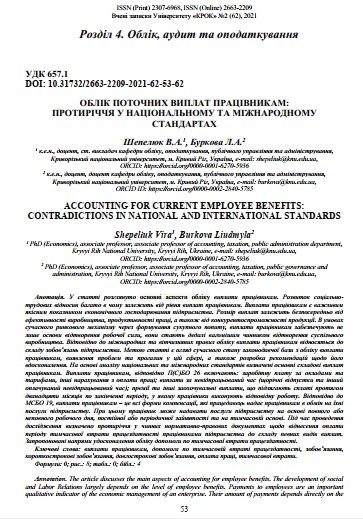ACCOUNTING FOR CURRENT EMPLOYEE BENEFITS: CONTRADICTIONS IN NATIONAL AND INTERNATIONAL STANDARDS
DOI:
https://doi.org/10.31732/2663-2209-2021-62-53-62Keywords:
employee benefits, temporary disability benefits, obligations, short-term obligations, long-term obligations, remuneration, temporary lossAbstract
The article discusses the main aspects of accounting for employee benefits. The development of social and Labor Relations largely depends on the level of employee benefits. Payments to employees are an important qualitative indicator of the economic management of an enterprise. Their amount of payments depends directly on the efficiency of production, labor productivity, as well as on the competitiveness of products. In the conditions of the modern market mechanism, through the formation of aggregate demand, payments to employees provide not only the basis for the reproduction of the labor force, they are becoming an increasingly significant factor in the reproduction of social production. In accordance with international and domestic accounting rules, employee benefits are included in the company's obligations. The purpose of the article is to review the current state of the legal framework for accounting for employee benefits, identify problems and gaps in this area, as well as develop recommendations for its improvement. Based on the analysis of national and international standards, the main components of employee benefits are determined. Payments to employees, in accordance with P (S)bu 26 include: wages on salaries and tariffs, other accruals from Labor remuneration; payments for unworked time (annual leave and other paid unworked time); bonuses and other incentive payments to be paid within twelve months after the end of the period in which employees perform the relevant work. Under IAS 19, employee benefits are all forms of compensation that an employer provides to employees in exchange for their services to the enterprise. At the same time, an employee can provide services to the enterprise on the basis of full or part-time work, permanent or periodic employment, and on a temporary basis. During the study, contradictions were identified in the current regulatory documents regarding the attribution of payment for the period of temporary disability by employees of the enterprise to certain types of payments. Directions for improving the accounting of temporary disability benefits are proposed.
Downloads
References
Міжнародний стандарт бухгалтерського обліку 19 «Виплати працівникам». URL: http://zakon2.rada.gov.ua/.
Про затвердження Положення (стандарту) бухгалтерського обліку 26 «Виплати працівникам». Наказ Міністерства фінансів України від 28.10.2003 р. № 601. URL: http://zakon4.rada.gov.ua/
Про затвердження Положення (стандарту) бухгалтерського обліку 11 «Зобов’язання». Наказ Міністерства фінансів України від 31.01.2000 р. № 20. URL: http://zakon2.rada.gov.ua/.
Інструкція про застосування Плану рахунків бухгалтерського обліку активів, капіталу, зобов'язань і господарських операцій підприємств і організацій: Наказ Міністерства фінансів України від 30 листопада 1999 р. № 291. URL: http://zakon3.rada.gov.ua/.



